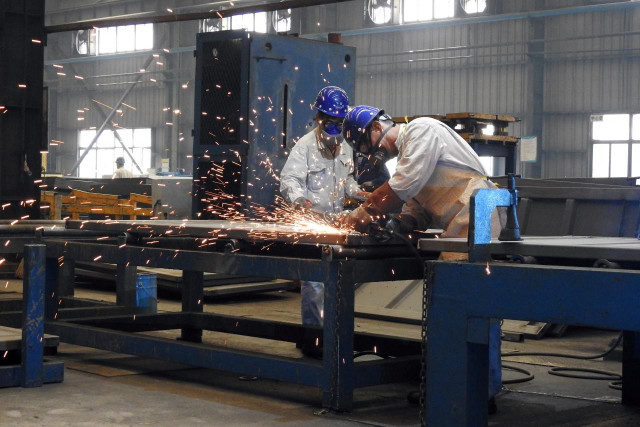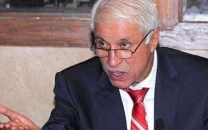Pakistan stuck in cycle of less sophisticated products
It is crucial to promote R&D in order to become globally competitive

Workers weld shipping container components at a container manufacturing company. PHOTO: REUTERS
An innovation-driven economy consistently develops new ideas and products and is at the frontier of product sophistication. Production is typically knowledge-intensive where labour is not only highly skilled but research and development (R&D) activities are rightly prioritised.
Unfortunately, considering the export composition of Pakistan and its evolution over the past few decades, Pakistan is stuck in a vicious cycle of producing less sophisticated products.
R&D is recognised as a vital component for the transition of a country into producing more sophisticated knowledge-intensive goods. R&D is required to improve technological sophistication of production, creating a better range of products in terms of not only a wider variety of products but also improved quality and their adaptation to different uses.
Further R&D allows promotion of branding and certification development in such a way that domestically produced goods are recognised and accepted by consumers in advanced foreign markets. In essence, R&D by research institutes, universities, businesses and various government agencies is undertaken to improve the competitive advantage.
R&D is often the backbone of an economy that is aimed at increasing value addition and consequently increasing the value of exports.
R&D expenditure as a percentage of gross domestic product (GDP) is defined by the World Development Indicators as the expenditure on basic research, applied research and experimental development in business enterprises, government, higher educational institutions and private non-profit organisations.
Pakistan has reported relatively low levels of R&D expenditure as a percentage of GDP compared to regional countries that have experienced episodes of significant economic as well as export growth. In 1997, Pakistan reported a value of 0.156% while Turkey, India and China reported values of more than 0.49%. Between 2002 and 2007, Pakistan experienced an increase as R&D expenditures rose from 0.22% to 0.632% in five years. In 2007, Turkey reported a value of 0.72% and India 0.82%. China increased the value to 1.37%.
However, since 2007, Pakistan experienced a sharp decline to 0.25% in 2015. This decline is disconcerting, particularly if the government desires an innovation-driven economy as recommended in the STPF 2015-18.
The value for China has now surpassed 2% and for Turkey it has surpassed 1%. Although the value for India has also declined, it still exceeds 0.6% of GDP.
‘Make in Pakistan’
The government aims to increase domestic production and substitute imports. However, for a campaign such as ‘Make in Pakistan’ to be successful, it must ensure that the goal is to make Pakistan globally competitive rather than focus on import substitutes. Hence, it is crucial to promote R&D activities.
The Global Innovation Index ranks Pakistan in its overall index at 109 out of 126 countries, in the category of number of researchers at 71 out of 104 countries and in gross expenditure on R&D activities at 85 out of 111 countries.
Pakistan does perform better when it comes to innovation linkages such as QS ranking of top three universities and university-industry linkages. However, it scores poorly in the index on the number of patent families filed by residents, implying a lack of technological innovation.
Basic research entails the creation of new knowledge using experimental or theoretical work, applied research is the creation of new knowledge directed towards a specific aim and experimental development is undertaken to develop or improve products, processes and services using existing knowledge.
Given the capabilities to perform basic research involving original research is likely to be limited in Pakistan, the focus must be on applied research as well as experimental design to enhance the level of sophistication for the production of goods.
The Atlas of Economic Complexity, developed by the Centre for International Development at Harvard University, placed Pakistan at 92 out of 127 countries in 2016, above Bangladesh but below India and Sri Lanka. Other countries such as Turkey, Vietnam and China have performed significantly better as indicated by their rankings.
They have experienced a change in their export basket, from being primarily exporters of basic products such as textiles and agricultural goods a few decades ago to major exporters of relatively more sophisticated products such as electronics and transportation equipment.
With investments being focused on the production of more sophisticated products, R&D activities in different sectors of the economy are likely to become increasingly necessary for such countries.
Rankings
According to the Global Competitiveness Index (GCI) 2017-18, published by the World Economic Forum, Pakistan is ranked 115 out of 137 countries.
Considering the rankings in business sophistication and innovation reported in the GCI, Pakistan is ranked poorly, or more than 100, in local supplier quantity and quality, extent of marketing, willingness to delegate authority and patent applications.
However, it is ranked higher, less than 60, in the state of cluster development, company spending on R&D and government procurement of advanced technology patents. Furthermore, Pakistan has failed to impress upon in rankings on indicators measuring technological readiness, such as internet usage and bandwidth as well as mobile broadband subscriptions, standing above 100. Although Pakistan is ranked relatively higher in certain aspects of innovation and business sophistication, it requires significant investment in upgraded technologies and needs to promote R&D activities within businesses, particularly entrepreneurs.
The government must realise that there is a complementary nature of R&D activities and the adoption of higher quality machinery and equipment. Imports of industrial machinery including textile machinery have been stagnant for the past 10 years, with no clear policy to increase the pace of industrialisation and technological adoption.
The purpose of R&D activities in Pakistan must be to develop the right mix of inputs including resources such as domestic labour. As an agrarian society, Pakistan must promote effective seed technology to enhance agricultural productivity.
In essence, R&D activities can lead to higher exports only when businesses have access to the desired inputs and capital goods.
The writer is the Assistant Professor of Economics and Research Fellow at CBER, IBA
Published in The Express Tribune, December 24th, 2018.
Like Business on Facebook, follow @TribuneBiz on Twitter to stay informed and join in the conversation.


















COMMENTS
Comments are moderated and generally will be posted if they are on-topic and not abusive.
For more information, please see our Comments FAQ